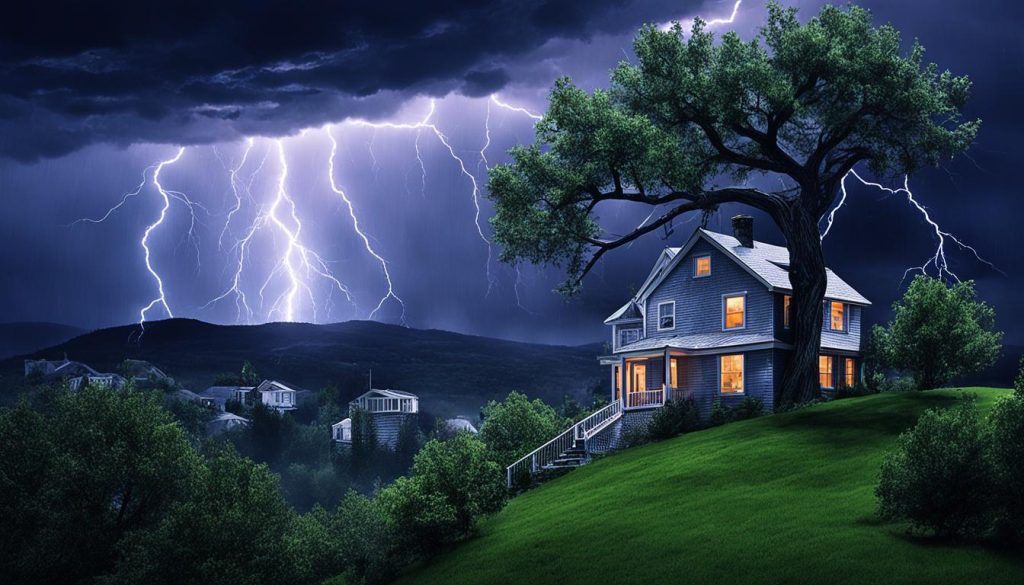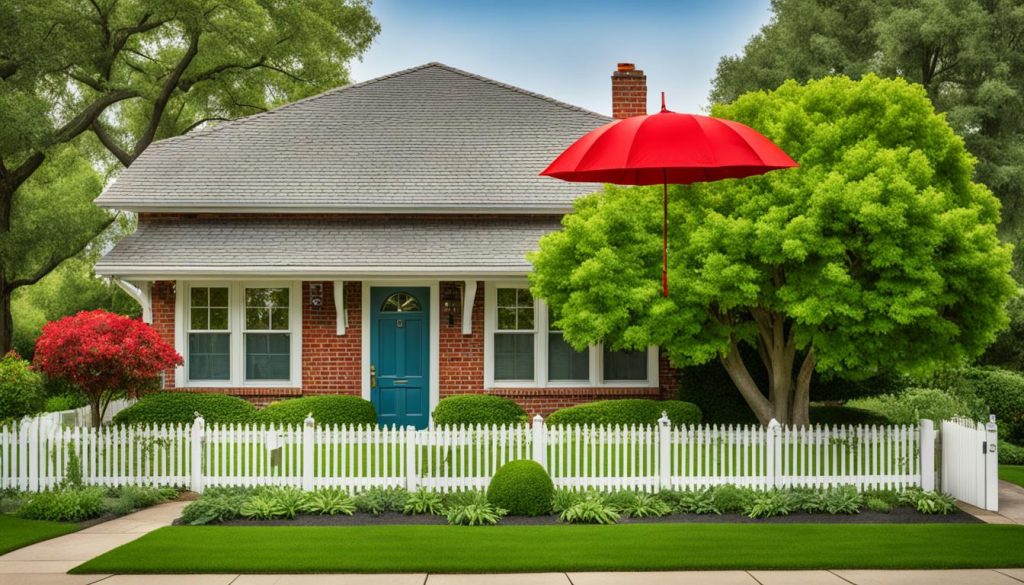Homeowners insurance is key to protecting your home, your biggest investment. It covers damage or loss to your home and its contents1. It also offers liability coverage, helping with costs if someone gets hurt on your property or if you’re sued1. Whether you’re new to homeownership or have been there for years, the right policy brings peace of mind.
Finding your way in homeowners insurance can feel overwhelming. But, we’re here to help you understand the coverage types and find a policy that fits your budget1. With customizable options and easy setup, you can make sure your home is well-protected.
Key Takeaways
- Homeowners insurance provides financial protection for your home and Personal Belongings
- Liability coverage can help cover legal fees and medical expenses if someone is injured on your property.
- Homeowners can bundle their car insurance with their homeowners policy to save on vehicle insurance rates1.
- Flood insurance is a separate policy that can provide additional protection against water damage1.
- Factors like location, home age, and safety devices can impact the cost of your homeowners insurance premiums1.
What is Homeowners Insurance?
Definition and Purpose
Homeowners insurance is a kind of property insurance. It protects homeowners if their home or its contents get damaged or lost2. This insurance is key to protecting your home, one of your biggest investments3. It covers personal items inside your home, usually between 50 to 70 percent of the home’s insurance value3. It also covers items kept outside, up to about 10 percent of the home’s insurance value.
Importance of Homeowners Insurance
Having good homeowners insurance is crucial for financial safety against unexpected events2. Lenders often require it, and policies last a year before renewing2. Liability protection helps pay for legal defense and awards up to the policy’s limit3. Additional living expenses (ALE) coverage can pay for hotel stays and meals while your home is being rebuilt, but limits and times vary3.
“Homeowners insurance is an essential safeguard for one of your biggest investments – your home.”
Types of Homeowners Insurance Coverage
Homeowners insurance policies offer many coverage options to protect your home and belongings. They cover everything from your property to liability. Let’s look at the main types of coverage you can get.
Property Damage Coverage
This coverage protects your home and structures like a garage from damage. It covers damage from fires, wind, hail, theft, and more4. In 2021, 78.2% of home insurance policies in the U.S. were HO-3, which cover the home against many dangers5.
Personal Property Coverage
This coverage protects your stuff like furniture and electronics if they get damaged or stolen6. For example, HO-5 policies offer more protection for your belongings than HO-3 policies.
Personal Liability Coverage
This coverage protects you and your family from legal costs if someone gets hurt at your home or by you6. HO-3 policies, the most common type, usually include this coverage.
Knowing about homeowners insurance coverages helps you choose the right policy for your home and belongings. By looking at the details, you can make sure your policy fits your needs and gives you peace of mind.

| Policy Type | Coverage Overview | Market Share (2021) |
|---|---|---|
| HO-1 | Basic coverage for the home structure, with limited protection for 10 specific perils | 1.8%4 |
| HO-2 | Broad coverage for the home and personal belongings, protecting against additional perils | 6.7%4 |
| HO-3 | The most common policy, providing open-peril coverage for the home and named-peril coverage for personal belongings | 78.2%4 |
| HO-5 | Comprehensive coverage for the home and personal belongings, with protection against a wide range of perils | 13%4 |
“Homeowners insurance is a crucial investment to protect your most valuable asset – your home. Understanding the different coverage types can help you find the right policy to safeguard your property and personal belongings.”
Looking at the different homeowners insurance options lets you tailor your policy to your needs. This way, you can get the full protection your home deserves465.
Factors Affecting Homeowners Insurance Costs
Protecting your home is important, and so is knowing the cost of homeowners insurance. Many factors can change how much you pay for coverage. Knowing these can help you save money on your insurance.
Replacement Cost
The cost to rebuild your home, known as the replacement cost, affects your insurance premiums. This includes materials, labor, inflation, and supply availability7. Insurance costs vary, from $946 a year for a $100,000 home to $3,066 for a $500,000 home.
Location and Risk Factors
Where your home is located and the risks it faces can change your insurance costs8. For example, homes in high-risk wildfire areas in California might pay more, up to over 300% more. In Florida, where hurricanes are common, the average cost of insurance can be over $4,000 a year.
Age and Condition of Home
The age and condition of your home also play a role in insurance costs8. Homes over 30 years old usually cost about 75% more to insure than new ones9. But, updating old homes can lower insurance costs. For example, modernizing electrical systems or replacing an old roof can help.
| Insurer | Annual Cost for New Home | Annual Cost for 50-Year-Old Home |
|---|---|---|
| Allstate | $947 | $1,717 |
| ASI Progressive | $659 | $1,850 |
Insurers also look at your credit score, marital status, and claims history when setting insurance costs9. Knowing these factors can help you make better choices and save on insurance.
Homeowners Insurance and Natural Disasters
Homeowners insurance is key when it comes to covering natural disasters10. Most policies cover damage from windstorms, hail, and fire. But, flooding is often not covered in standard policies10. If you live in a flood-prone area, you might need extra flood insurance for your home and stuff.
Natural disasters can really affect home insurance costs11. In 2023, there were 28 billion-dollar disasters, with 11 by June 202411. The average cost for homeowners insurance in the U.S. is about $2,230 a year for $300,000 in coverage11. Experts say home insurance costs will keep going up due to more extreme weather.
Standard homeowners insurance usually doesn’t cover earthquakes, floods, or other disasters11. Climate change makes these disasters more common and severe, causing insurance rates to go up11. If you live in a place often hit by hurricanes or wildfires, you might pay more for insurance.
To make sure you’re fully protected, check your insurance and think about extra policies like flood or earthquake insurance if needed12. The NFIP paid out about $69,000 on average for flood claims over five years, and flood insurance costs around $88812. Earthquake insurance, which isn’t usually part of homeowners insurance, costs between $100-$300 a year. Almost half of the U.S. is at risk for earthquakes.

With more natural disaster risks, homeowners need to stay informed and take action to protect their homes and money. Knowing what your insurance covers and looking into extra policies can help keep your property and finances safe from nature’s surprises101112.
Claim processes and Deductibles
Understanding how to file homeowners insurance claim processesand what deductibles mean is key. The deductible is what you pay first before your insurance helps out13. Picking a higher deductible can make your insurance cheaper, but you’ll pay more if you make a claim13.
Understanding Deductibles
Deductibles vary among insurance companies and can change your premium13. Right now, the average cost of home insurance is $2,230 yearly for a $300,000 home with a $1,000 deductible13. Choosing a $2,000 deductible can lower your yearly premium to $2,04613. In places often hit by storms, you might have an extra deductible for hurricane protection13. For areas at high risk of natural disasters like earthquakes or floods, deductibles can be up to 10% of your home’s insured value13.
14 Most homeowners insurance policies have deductibles between $500 and $2,00014. For claims related to wind, hail, or hurricanes, deductibles can be 1% to 10% of your home’s insured value14. In California, the minimum deductible for earthquake claims is about 15% of the insured value14. Flood insurance deductibles can be from $1,000 to $10,000 for both building and contents damage14. The average cost for homeowners insurance deductibles is between $100 and $5,000, with an average of $50014.
Filing a Claim
15 Deductibles can be a set amount or a percentage of your policy’s total coverage, usually applying to homeowners policies15. For example, a 2 percent deductible on a $100,000 home means a $2,000 deduction on a $10,000 insurance loss, leaving you with $8,000 from the claim15. Florida and Louisiana have hurricane deductibles that apply once a year, not per storm15.
To file a claim, you contact your insurance company, give them details about the incident, and work with them to check the damage and see what you’re covered for. Rarely, homeowners insurance deductibles can be waived, like if your home is completely destroyed and needs rebuilding13.
Discounts and Incentives
Homeowners insurance can be a big expense. But, there are discounts and incentives to help lower your costs. By bundling policies or investing in safety devices, you can save a lot.
Multi-Policy Discounts
One way to save is through multi-policy discounts. Bundling your home and auto insurance can save you about 30%16. Insurers also offer discounts for loyalty, like staying with the same company for five years17.
Home Safety Devices
Home safety devices like smoke detectors and burglar alarms can cut your insurance costs17. These features lower the risk of claims, so insurers offer discounts. Smart home devices, such as video doorbells, can also save you money17.
Other home upgrades can save you money too. Fire-resistant materials and Energy Star-rated appliances might get you discounts17. New or recently renovated homes are seen as less risky, which can save you more17.
It’s key to check your insurance policy for all available discounts. Talking to your provider about these can help you save. This way, you get peace of mind and save money for your home161817.
“Bundling policies, such as home and auto insurance, can lead to savings, but other factors affect insurance costs as well.”18
Homeowners Insurance
Homeowners insurance is key to protecting your home and stuff. It covers risks like property damage, theft, and liability claims19. By knowing what your policy covers and what affects its cost, you can tailor it to fit your needs and budget.
Every mortgage lender requires homeowners insurance19. Some lenders let you skip mortgage insurance with a bigger down payment19. This insurance covers your home’s structure, your stuff, temporary living arrangements, and liability claims19. You can drop private mortgage insurance once you’ve built over 20% equity in your home19. It protects the lender if you default, and it protects you, your home, and your belongings from disasters19.
A 2023 survey by State Farm found new customers can save an average of $X a year by switching20. But, you can’t get a discount for buying just one policy20. Savings and discounts vary by state20.
Homeowners insurance covers damage to your house and other buildings on your property20. You can add earthquake coverage for extra premium or buy a separate policy20. Flood damage isn’t covered by standard policies. You need a separate flood insurance policy, usually from the National Flood Insurance Program20.
A 2022 study by U.S. News & World Report looked at over 15 homeowners insurance companies21. Ratings came from professional and consumer reviews21. They looked at how often people searched for these companies to find the most popular ones21.

Getting homeowners insurance is a smart move to protect your home. By understanding what’s covered and what affects the cost, you can pick the right policy. It’s important for both first-time buyers and long-time owners to review their insurance needs. This way, you get peace of mind and financial security.
Choosing the Right Coverage Amount
Protecting your home and belongings is crucial. You need the right homeowners insurance coverage. To make sure you’re covered, look at your home’s replacement cost, your belongings’ value, and any extra risks you might face.
Assessing Your Needs
First, think about how much it would cost to rebuild your home. This is the total cost of materials and labor22. Most policies cover your belongings at 50 to 70 percent of your home’s insurance value22. Also, replacing your home costs about 10 percent more than just covering its current value22.
For your personal stuff, making a detailed list helps you figure out how much coverage you need23. Your stuff is usually covered for a certain percentage of your home’s value, between 50% to 70%23. But, remember, standard policies might only cover jewelry up to $2,00022.
Liability coverage is also key22. Most policies start with $100,000 in liability insurance, but you should aim for $300,000 to $500,0002223. Umbrella policies kick in after your basic insurance is used up. They require at least $300,000 of basic liability insurance23.
Personal Property Inventory
Listing your personal property helps you know how much coverage you need23. Some policies offer limited coverage for things like jewelry, electronics, and guns23. By documenting your items, you can make sure your coverage matches their real value24. A digital inventory makes filing claims easier if your stuff gets damaged24.
By evaluating your needs and making a detailed list of your belongings, you can make sure your insurance covers everything. This way, you’ll be ready for anything unexpected.

Conclusion
Homeowners insurance is key to protecting your home and stuff. It helps you understand the different types of coverage and how they work. This way, you can make a policy that fits your needs and gives you peace of mind25.
If you’re buying your first home or have owned one for years, checking your Homeowners Insurance Conclusion is smart. It helps protect your biggest investment and gets you ready for surprises2627.
The Importance of Home Insurance is huge. It keeps you safe from losing money if your property gets damaged, if someone sues you, or if a disaster hits. With a good homeowners insurance policy, you can relax knowing your home and things are safe. This lets you enjoy your home and make memories25.
FAQ
What is homeowners insurance?
Homeowners insurance protects your home and its contents from damage or loss. It also covers you against accidents that happen at your home or on your property.
Why is homeowners insurance important?
It’s key to safeguard your home, a big investment. It shields you from unexpected accidents or events that could cause big financial losses. This gives you peace of mind.
What types of coverage does homeowners insurance include?
Policies usually have Property Damage, Personal Property, and Personal Liability coverage. These cover your home, belongings, and protect you from liability.
What factors affect the cost of homeowners insurance?
Several factors affect your policy’s cost. These include your home’s replacement cost, location risks, and its age and condition.
Does homeowners insurance cover natural disasters?
Yes, it covers damage from windstorms, hail, and fire. But, flooding might not be covered by standard policies. High-risk areas might need extra flood insurance.
How does the claims process work for homeowners insurance?
Start by contacting your insurer about the incident. Then, provide details and work with them to assess the damage. Remember, you’ll pay your deductible before insurance covers the rest.
What types of discounts and incentives are available for homeowners insurance?
Insurers offer discounts to lower your policy cost. You might get a discount for bundling policies or installing safety devices at home.
How do I choose the right amount of homeowners insurance coverage?
Pick the right coverage by evaluating your needs. Consider your home’s replacement cost, your belongings’ value, and any extra risks. A detailed inventory of your property can guide you in choosing the right coverage.
Source Links
- Homeowners Insurance
- What is Home Insurance & How Does it Work?
- Understanding Basic Homeowners Insurance | Department of Insurance, SC
- 8 Types of Homeowners Insurance – Policygenius
- Types of Homeowners Insurance | Bankrate
- 8 Types of Homeowners Insurance Policies
- 11 Factors That Affect Home Insurance Rates – Policygenius
- 10 Factors That Impact the Cost of Homeowners Insurance – Experian
- Factors That Impact Your Cost of Homeowners Insurance | Bankrate
- Does Home Insurance Cover Natural Disasters?
- The Impact of Natural Disasters on Insurance Rates in 2024 | Bankrate
- What Disasters Does Home Insurance Cover? | Bankrate
- What Is a Homeowners Insurance Deductible? | Bankrate
- Homeowners Insurance Deductible Explained
- Understanding your insurance deductibles | III
- Homeowners Insurance Discounts & Savings – Policygenius
- How to Get Homeowners Insurance Discounts – NerdWallet
- How To Get Homeowners Insurance Discounts
- What’s the Difference Between Homeowners Insurance and Mortgage Insurance? | Travelers Insurance
- Homeowners Insurance Coverage | Easy Free Online Quotes
- Best Homeowners Insurance Companies
- How much homeowners insurance do I need?
- How Much Homeowners Insurance Do You Need? – NerdWallet
- How Much Homeowners Insurance Do I Need? | Bankrate
- Do I Need Homeowners Insurance and When Should I Buy It? | Travelers Insurance
- Do You Need to Buy Home Insurance Before Closing? – Policygenius
- Homeowners Insurance premium at Closing | What to Know | Credible

